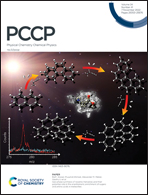Electrically modulated reversible dual-spin filter in zigzag β-SiC7 nanoribbons†
Abstract
Compared with traditional magnetic approaches, electrical modulation of spin-polarized current can greatly reduce the energy consumption and scale of nanodevices and improve their operating speed, which has become a promising research field in spintronics. Motivated by the latest reported novel two-dimensional material β-SiC7, we employ first-principles calculations to investigate its spin-dependent electron transport with diverse edge configurations. By introducing a gate voltage, the three-terminal device can not only switch between spin-unpolarized and fully spin-polarized states, but also easily change the polarization direction, behaving as an excellent electrically modulated reversible dual-spin filter. Surprisingly, an arbitrary proportion of spin-up and spin-down electron numbers is achieved, enabling precise control of spin polarization. Analysis reveals that it is attributed to the peculiar transmission spectrum, where two broad peaks with opposite spins are located around the Fermi level and respond differently to gate voltage. They belong to the spatially separated edge states originating from the p orbitals of the edge atoms. This feature is robust to different edge configurations of β-SiC7 nanoribbons, indicating that this may be an intrinsic property of such systems, showing great potential for applications.



 Please wait while we load your content...
Please wait while we load your content...